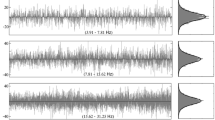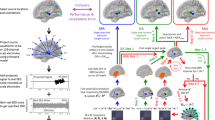Abstract
Event-related potentials (ERPs) recorded on the surface of the head are a mixture of signals from many sources in the brain due to volume conductions. As a result, the spatial resolution of the ERPs is quite low. Blind source separation can help to recover source signals from multichannel ERP records. In this study, we present a novel implementation of a method for decomposing multi-channel ERP into components, which is based on the modeling of second-order statistics of ERPs. We also report a new implementation of Bayesian Information Criteria (BIC), which is used to select the optimal number of hidden signals (components) in the original ERPs. We tested these methods using both synthetic datasets and real ERPs data arrays. Testing has shown that the ERP decomposition method can reconstruct the source signals from their mixture with acceptable accuracy even when these signals overlap significantly in time and the presence of noise. The use of BIC allows us to determine the correct number of source signals at the signal-to-noise ratio commonly observed in ERP studies. The proposed approach was compared with conventionally used methods for the analysis of ERPs. It turned out that the use of this new method makes it possible to observe such phenomena that are hidden by other signals in the original ERPs. The proposed method for decomposing a multichannel ERP into components can be useful for studying cognitive processes in laboratory settings, as well as in clinical studies.









Similar content being viewed by others
Data Availability
No specific synthetic datasets used in this work were generated. All synthetic datasets were generated just before use and were not saved. The algorithm for generating these data is described in Supplementary materials 1. A C + + implementation of this algorithm is available from the corresponding author on reasonable request. The results of the analysis of real ERP taken from a large data set (HBI database) are given for illustrative purposes only, since the properties of hidden sources of real ERP are not known in advance.
References
Afsari B (2006) Simple LU and QR based non-orthogonal matrix joint diagonalization. Independent Component Analysis and Blind Signal Separation. Springer, Berlin, pp 1–7. https://doi.org/10.1007/11679363_1
Amari SI, Cichocki A, Yang HH (1996) A new learning algorithm for blind source separation. In Advances in Neural Information Processing Systems, Denver, pp 757–763
Belouchrani A, Abed-Meraim A, Cardoso J-F, Moulines E (1997) A blind source separation technique using second order statistics. IEEE Trans Signal Process 45:434–444. https://doi.org/10.1109/78.554307
Chen Y, Wiesel A, Eldar YC, Hero AO (2010) Shrinkage algorithms for MMSE covariance estimation. IEEE Trans Signal Process 58:5016–5029. https://doi.org/10.1109/TSP.2010.2053029
Cheng G, Li S, Miao J, Moreau E (2018) LU-based Jacobi-like algorithms for non-orthogonal joint diagonalization. Comput Math Appl 76:113–124. https://doi.org/10.1016/j.camwa.2018.04.007
Chib S (1995) Marginal likelihood from the Gibbs output. J Am Stat Assoc 90:1313–1321. https://doi.org/10.1080/01621459.1995.10476635
Comon P, Jutten C (eds) (2010) Handbook of blind source separation: independent component analysis and applications. Academic Press, Oxford
Congedo M, John RE, Ridder DD, Prichep L (2010) Group independent component analysis of resting state EEG in large normative samples. Int J Psychophysiol 78:89–99. https://doi.org/10.1016/j.ijpsycho.2010.06.003
Field AS, Graupe D (1991) Topographic component (parallel factor) analysis of multichannel evoked potentials: practical issues in trilinear spatiotemporal decomposition. Brain Topogr 3:407–423. https://doi.org/10.1007/BF01129000
Gong XF, Wang XL, Lin QH (2015) Generalized non-orthogonal joint diagonalization with LU decomposition and successive rotations. IEEE Trans Signal Process 63(5):1322–1334. https://doi.org/10.1109/TSP.2015.2391074
Hansen LK, Larsen J, Kolenda T Blind detection of independent dynamic components. In Proc. of ICASSP01, Vol. 5, City SL (2001) UT, USA (pp. 3197–3200). https://doi.org/10.1109/ICASSP.2001.940338
Jung TP, Makeig S, Westerfield M, Townsend J, Courchesne E, Sejnowski TJ (2001) Analysis and visualization of single-trial event-related potentials. Hum Brain Map 14:166–185. https://doi.org/10.1002/hbm.1050
Knuth K, Shah A TruccoloW Ding M, Bressler SL, Schroeder CE (2006) Differentially variable component analysis: identifying multiple evoked components using trial-to-trial variability. J Neurophysiol 95:3257–3276. https://doi.org/10.1152/jn.00663.2005
Kolenda T, Hansen LK, Larsen J (2001) Signal detection using ICA: application to chat room topic spotting. In Proc. of ICA’2001, pp 540–545 http://www.imm.dtu.dk/pubdb/p.php?826
Kropotov JD, Ponomarev VA (2015) Differentiation of neuronal operations in latent components of event-related potentials in delayed match-to-sample tasks. Psychophysiology 52:826–838. https://doi.org/10.1111/psyp.12410
Kropotov J, Ponomarev V, Tereshchenko EP, Muller A, Jancke L (2016) Effect of aging on ERP components of cognitive control. Front Aging Neurosci. https://doi.org/10.3389/fnagi.2016.00069
Kuleshov V, Chaganty A, Liang P (2015) Simultaneous diagonalization: the asymmetric, low-rank, and noisy settings. In CoRR abs/1501.06318
Luck SJ, Kappenman ES (2011) The Oxford handbook of event-related potential components. Oxford University Press, Oxford
MacKay DJC (1992) Bayesian model comparison and backprop nets. In Advances in Neural Information Processing Systems No. 4 Morgan Kaufmann, San Mateo, CA, pp 839–846 https://resolver.caltech.edu/CaltechAUTHORS:20160121-165028464
Makeig S, Westerfield M, Jung TP, Enghoff S, Townsend J, Courchesne E, Sejnowski TJ (2002) Dynamic brain sources of visual evoked responses. Science 295:690–694. https://doi.org/10.1126/science.1066168
Maris E, Oostenveld R (2007) Nonparametric statistical testing of EEG- and MEG-data. J Neurosci Methods 164:177–190. https://doi.org/10.1016/j.jneumeth.2007.03.024
Miwakeichi F, Martinez-Montes E, Valdés-Sosa PA, Nishiyama N, Mizuhara H, Yamaguchi Y (2004) Decomposing EEG data into space–time–frequency components using parallel factor analysis. NeuroImage 22:1035–1045. https://doi.org/10.1016/j.neuroimage.2004.03.039
Mørup M, Hansen LK, Herrmann CS, Parnas J, Arnfred SM (2006) Parallel factor analysis as an exploratory tool for wavelet transformed event-related EEG. NeuroImage 29:938–947. https://doi.org/10.1016/j.neuroimage.2005.08.005
Mørup M, Hansen LK, Arnfred SM, Lim LH, Madsen KH (2008) Shift-invariant multilinear decomposition of neuroimaging data. NeuroImage 42:1439–1450. https://doi.org/10.1016/j.neuroimage.2008.05.062
Nunez PL, Srinivasan R (2006) Electric Field of the brain, 2nd edn. Oxford University Press, New York
Pascual-Marqui RD (2002) Standardized low-resolution brain electromagnetic tomography (sLORETA): technical details. Methods Find Exp Clin Pharmacol 24:5–12 Suppl D
Ponomarev VA, Kropotov YD (2013) Improving source localization of event-related potentials in the GO/NOGO task by modeling their cross-covariance structure. Hum Physiol 39:27–39. https://doi.org/10.1134/S036211971301012X
Ponomarev VK, Kropotov YD (2021) Bayesian parallel factor analysis for studies of event-related potentials. Neurosci Behav Physiol 51:882–892. https://doi.org/10.1007/s11055-021-01147-6
Ponomarev VA, Mueller A, Candrian G, Grin-Yatsenko VA, Kropotov JD (2014) Group independent component analysis (gICA) and current source density (CSD) in the study of EEG in ADHD adult. Clin Neurophysiol 125:83–97. https://doi.org/10.1016/j.clinph.2013.06.015
Ponomarev VA, Pronina MV, Kropotov YD (2019) Parallel factor analysis in the study of event-related potentials. Hum Physiol 45:233–241. https://doi.org/10.1134/S0362119719030150
Rasmussen PM, Morup M, Hansen LK, Arnfred SM (2008) Model order estimation for independent component analysis of epoched EEG signals. In Proc. of the First International Conference on Bio-inspired Systems and Signal Processing (BIOSIGNALS ’08) Vol. 2, pp 3–10
Souloumiac A (2009) Nonorthogonal joint diagonalization by combining Givens and hyperbolic rotations. IEEE Trans Signal Process 57:2222–2231. https://doi.org/10.1109/TSP.2009.2016997
Tang A, Sutherland M, Wang Y (2006) Contrasting single-trial ERPs between experimental manipulations: improving differentiability by blind source separation. NeuroImage 29:335–346. https://doi.org/10.1016/j.neuroimage.2005.07.058
Verleger R, Paulick C, Möcks J, Smith JL, Keller K (2013) Parafac and go/no-go: disentangling CNV return from the P3 complex by trilinear component analysis. Int J Psychophysiol 87:289–300. https://doi.org/10.1016/j.ijpsycho.2012.08.003
Vigário RN (1997) Extraction of ocular artefacts from EEG using independent component analysis. Electroencephalogr Clin Neurophysiol 103:395–404. https://doi.org/10.1016/s0013-4694(97)00042-8
Wang K, Gong XF, Lin QH (2012) Complex non-orthogonal joint diagonalization based on LU and LQ decompositions. Latent Variable Analysis and Signal Separation. Springer, Berlin, pp 50–57. https://doi.org/10.1007/978-3-642-28551-6_7
Wu W, Wua C, Gao S, Liuc B, Li Y, Gao X (2014) Bayesian estimation of ERP components from multicondition and multichannel EEG. NeuroImage 88:319–339. https://doi.org/10.1016/j.neuroimage.2013.11.028
Yeredor A (2010) Second-order methods based on color. In: Comon P, Jutten C (eds) Handbook of blind source separation: independent component analysis and applications Oxford. Academic Press, Cambridge, pp 227–280
Zhong M, Girolami M (2012) A Bayesian approach to approximate joint diagonalization of square matrices. In Proc. 29th Int Conf Mach Learn, pp 651–658
Acknowledgements
Special thanks to A. Muller (Children’s Research Center, Chur, Switzerland) for organizing EEG recordings in the visual cued Go-Nogo task.
Funding
This work was carried out as part of the State Assignment of the Ministry of Education and Science of the Russian Federation (project 122041300021-4).
Author information
Authors and Affiliations
Contributions
All authors contributed to the study conception and design. Material preparation, data collection and analysis were performed by VAP and JDK. The first draft of the manuscript was written by VAP. The manuscript was edited and revised by VAP and JDK. All authors read and approved the final version of manuscript.
Corresponding author
Ethics declarations
Conflict of interest
The authors have no competing interests to declare that are relevant to the content of this article.
Ethical Approval
During the collection of a large data set (HBI database), all studies conducted in accordance with principles for human experimentation as defined in the Declaration of Helsinki and International Conference on Harmonization Good Clinical Practice guidelines, and approved by the Ethics Committee of the N. P. Bechtereva Institute of the Human Brain, Russian Academy of Sciences (IHB RAS), St. Petersburg, Russia and the Local ethics committee of the canton Graubunden, district of Grison (Switzerland).
Consent to Participate
Informed consent was obtained from each study participant after they were informed of the potential risks and benefits, as well as the exploratory nature of the study.
Additional information
Handling Editor: Christoph Michel.
Publisher’s Note
Springer Nature remains neutral with regard to jurisdictional claims in published maps and institutional affiliations.
Supplementary Information
Below is the link to the electronic supplementary material.
Rights and permissions
Springer Nature or its licensor (e.g. a society or other partner) holds exclusive rights to this article under a publishing agreement with the author(s) or other rightsholder(s); author self-archiving of the accepted manuscript version of this article is solely governed by the terms of such publishing agreement and applicable law.
About this article
Cite this article
Ponomarev, V.A., Kropotov, J.D. Second Order Blind Identification of Event Related Potentials Sources. Brain Topogr 36, 797–815 (2023). https://doi.org/10.1007/s10548-023-00998-1
Received:
Accepted:
Published:
Issue Date:
DOI: https://doi.org/10.1007/s10548-023-00998-1




